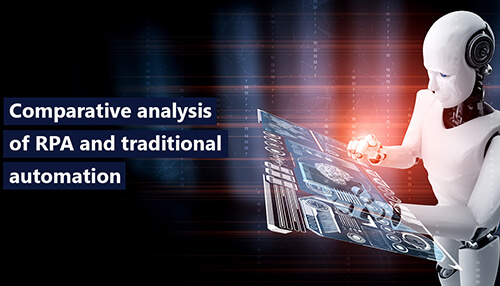In the wake of the digital revolution, the implementation of RPA and traditional automation has been rocketing very high in recent times in all industries and domains. Consequently, the demand for Robotic Process Automation (RPA) solutions has plummeted compared to traditional automation with the companies implementing RPA to compete and stay afloat in the business game. With RPA receiving a lot of attention recently, it has taken a leap forward to transform the dynamics of business operations for its ability to reduce turnaround time, enhance accuracy and productivity, and better regulatory compliance.
What is RPA?
RPA is a technological solution for automating manual business procedures to allow organizations to stay competitive and flourish in the technological landscape. By combining automation with artificial intelligence, organizations can restore numerous rule-based, repetitive, and human operations. The application of RPA solutions like the AI-powered Assist Edge RPA tool will lead to faster, more secure, and more reliable services.
EdgeVerve Systems’ Assist Edge RPA
EdgeVerve Systems’ Assist Edge RPA offers end-to-end automation with related intelligence and OCR (Optical Character Recognition) resources. It predicts alerts about bot performance and service level agreement (SLA) failures that allow businesses to stay ahead of any issues. The business intelligence dashboards consist of data on both historical performance and forecasting with actionable insights. Additionally, it also incorporates enterprise-grade security and access features, together with GDPR compliance and assimilations with CyberArk’s Credential Vault. Assist Edge has over 120 operations, including the blend of RPA with email bots and chatbots.
What is traditional automation?
Traditional automation is a solution to any repetitive work. It is normally used in enterprise production lines, including screen scraping, part assembly, and many more. It also needs application integration in the database or facility matter. This work can take a long time to complete.
RPA versus Traditional Automation
RPA and traditional automation can be differentiated based on five aspects:
- Technology
- Software limitations
- Customization
- Cost Efficiency
Technology
Traditional automation functions primarily on APIs, programming, and some other unified methods. RPA is unique in the sense that it repeats user actions at the user interface (UI) level. Additionally, automated robots or bots can work on systems without APIs or legacy. This is a big advantage of RPA compared to traditional automation.
Software Limitations
It is extremely tough to apply traditional automation in the absence of an IT staff to program the system as the automation process needs one to have programming-related knowledge.
RPA works on the user interface (UI), hence automated robots can do the tasks without programmers.
Time Efficiency
Implementing RPA to your business can speed up the task and it may take just a few weeks to get the job done. On the other hand, it will take months to deploy with traditional automation.
For example, RPA can provide payroll data by extracting data from Word documents without needing integration. However, traditional automation demands assimilation with some other software to extract data.
Customization
The next distinction between Traditional automation and RPA is customization ability. Automated robots have the capability to work on systems without APIs, but traditional automation cannot do so. Hence, users must design RPA robots to meet their specified requirements. Automated robots can be integrated with applications like CRM, ERP, calendar, and E-mail to synchronize information and generate automatic responses.
Cost Efficiency
RPA helps businesses to solve monotonous and repetitive tasks. It can efficiently replenish human work with absolute accuracy. Consequently, employees will be liberated, thus moving to more value-added creative work. In this way, businesses can make the most out of their employees’ resources and provide the ideal ROI.
Initially, the investment cost of RPA may be more costly than traditional automation. However, traditional automation will cost more compared to RPA eventually.
RPA versus traditional automation: When to use what?
Replacing RPA with traditional automation is not possible as traditional automation still has its niche applications. For instance, traditional automation gets the job done rapidly while transferring a huge amount of data between systems.
RPA is better compared to traditional automation whenever businesses need to automate certain processes in their work system such as invoice processing, order creation, and data access. Because RPA works on the user interface (UI), it is considered a ‘software virtual assistant which assists people do desk jobs swiftly. Moreover, RPA has flexible working hours as it can work 24 hours continuously. Hence, the application of automated robots is completely sensible.
Conclusion
While RPA is a better option compared to the traditional automation race in the majority of the processes, it is not going to totally replace traditional automation, which still has applications in numerous systems. Traditional Automation and RPA have their own work and are still successfully running in various industries, companies, and businesses. Each automation has its own merits and demerits to it. Therefore, it entirely depends upon an organization or a business which automation they would like to apply. Thus, the implementation of the traditional automation can be completely ruled out.



